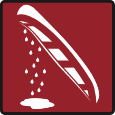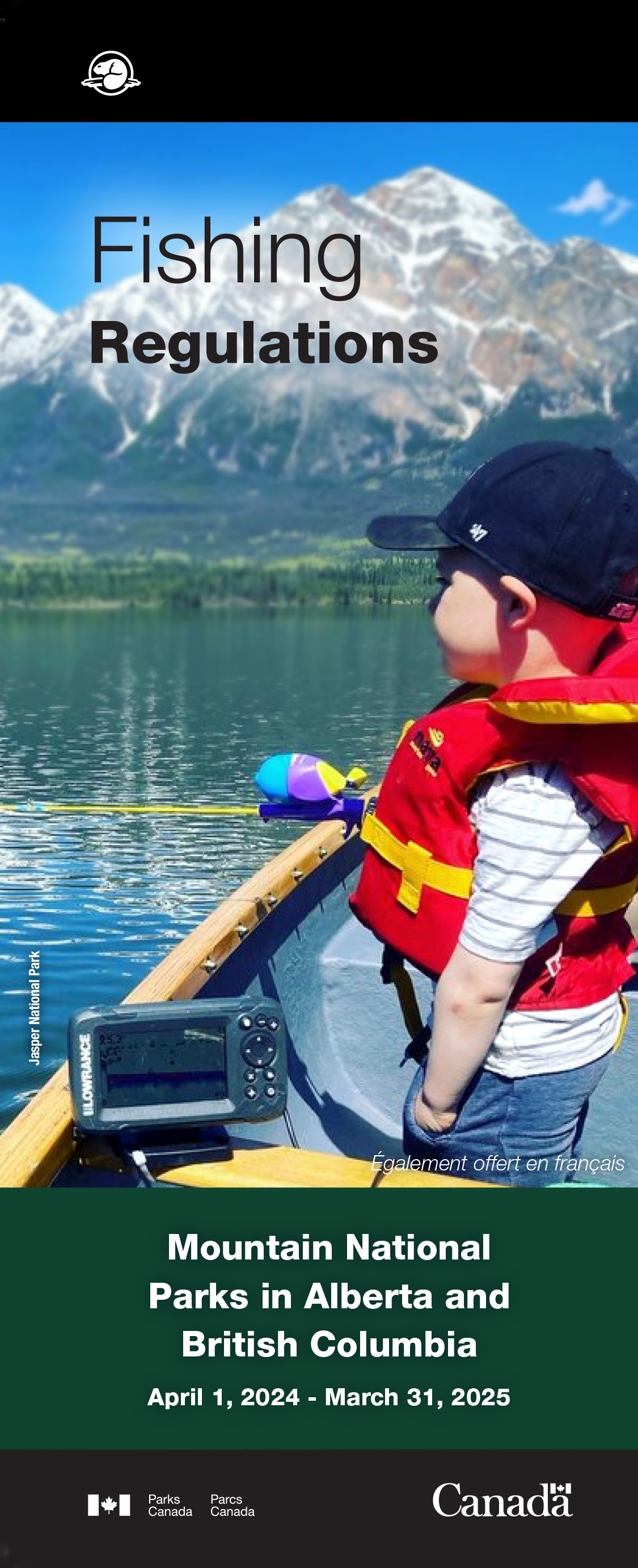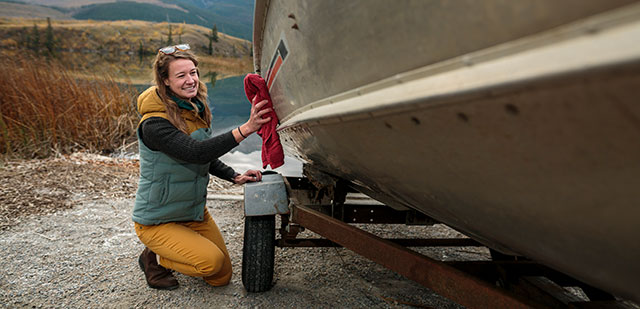
Fishing regulations summary
Jasper National Park
Fishing permits
A national park fishing permit is required when angling in Canada's national parks. Provincial fishing licenses are not valid.
Anyone under the age of 16 may fish in the national parks without a permit if accompanied by a national park fishing permit holder 16 years of age or older. However, their catch is then included within the permit holder’s daily limit. A valid national park pass is also required when fishing in the mountain national parks.
National Parks of Canada Fishing Regulations
April 1, 2024 to March 31, 2025
It is unlawful to:
- Fish without a national park fishing permit in your immediate possession
- Fish with or possess within 100 metres of park waters the following:
- natural bait and chemical attractants;
- any lead tackle (sinkers, jigs, lures and flies) under 50 grams;
- lures with more than 2 gang hooks;
- a line capable of catching more than one fish at one time;
- live or dead fish or any parts thereof for use as bait.
- Fish by any method other than angling
- Fish with more than one line at a time
- Fish with a line having more than one artificial fly
- Fish closed waters
- Leave a fishing line unattended
- Fish from 2 hours after sunset to one hour before sunrise
- Sell, trade or barter any fish caught
- Place or transfer any fish or fish eggs between any park waters
- Place any food for fish in park waters
- Harass fish by throwing objects or impeding their movements
When fishing in park waters that allow possession (see Catch and Possession Limits), it is unlawful to:
- Possess more than 2 game fish at one time
- Continue fishing on any day after having caught and retained the maximum daily catch and possession limit
- Allow your catch to spoil or to be wasted
For a complete listing, please refer to the National Parks of Canada Fishing Regulations.
Check your tackle box!
Some fishing tackle and baits are not allowed near or within 100 metres of national park waters. Refer to the National Parks of Canada Fishing Regulations.
Open seasons, special restrictions and closed waters
Open seasons - rivers and streams
| Year round | Sunwapta River |
| March 30 to September 2 and November 1 to March 31 | Fiddle River, Maligne River (below Maligne Canyon), Miette River, Rocky River, Snake Indian River, Snaring River |
| August 1 to October 1 | Fly fishing only: Maligne River from a point 420 m downstream from the Maligne Lake Outlet bridge to Medicine Lake including that part of Medicine Lake within a 180 m radius of a point in the middle of the Maligne River where it enters Medicine Lake. Use artificial flys only. |
| June 29 to September 2 | All other rivers and streams except closed waters |
Open seasons - Athabasca River
Note: The Athabasca River has three fisheries management zones.
| Year round | Zone 1: From Athabasca Falls upstream |
| March 30 to September 2 and November 1 to March 31 | Zone 2: From 12 Mile Bridge (km 22, Hwy 16 East) upstream to Athabasca Falls |
| June 1 to September 2 and November 1 to March 31 | Zone 3: From 12 Mile Bridge (km 22, Hwy 16 East) downstream to east park boundary, including all side channels, Pocahontas Ponds and other connected wetlands |
| June 29 to September 2 | All other rivers and streams except as specified in Schedule IV. |
Open seasons - lakes
| May 18 to September 2 | Annette Lake, Beaver Lake, Dragon Lake, Long Lake, Lorraine Lake, Moab Lake, Mona Lake, No Name Lake (Hwy 93 South, km 48), Pyramid Lake, Lakes Three, Four and Five in the Valley of the Five Lakes |
| May 18 to September 30 | Maligne Lake, Talbot Lake, Edna Lake |
| June 29 to October 31 | Fly fishing only: Medicine Lake. Use artificial flys only. |
| June 29 to October 31 | All other lakes except closed waters |
Closed waters
- Maligne Lake Outlet/Maligne River (the portion including the part of Maligne Lake within a 100 m radius of a point in the middle of the Maligne River where it leaves Maligne Lake, to a point 420 m downstream from the Maligne Lake Outlet bridge)
- Jacques Lake and Jacques Lake Outlet stream between Jacques Lake and the Rocky River
- Mile 9 (km 15) Lake, Highway 16 (East)
- All streams emptying into Amethyst Lake
- The part of Amethyst Lake situated within a 180 m radius from a point in the middle of the outlet stream from the southeast end of Amethyst Lake
- The part of the Astoria River situated between Amethyst Lake and a point 400 m downstream from Amethyst Lake
- Osprey Lake
- The outlet stream from Moab Lake to its junction with the Whirlpool River, including that part of Moab Lake situated within a 180 m radius of a point in the middle of the outlet stream where it leaves Moab Lake
- The outlet stream from Beaver Lake to its junction with the Maligne Lake Road
Special restrictions
Felt-soled boots are not permitted in any water body in Jasper National Park
Definitions
- Angling
- Fishing with a hook and line held in the hand or with a hook, line and rod held in the hand. It does not mean fishing with a set line.
- Artificial fly
- A single or double hook on a common shank, dressed with silk, tinsel, wood, fur, feathers or other materials (no lead), or any combination thereof without a spinning device, whether attached to the hook or line.
- Natural bait ban
- You can only use lures made of feathers, fibre, rubber, wood, metal or plastic. No edible material (plant or animal products), scented lures or chemical attractants are permitted.
- Tributary
- Any water course which flows into another body of water. This includes a tributary to a tributary. Lakes are excluded unless otherwise specified.
- Trout
- For the purposes of this summary, the word trout includes char species.
Protect park waters
Preventing the spread of aquatic invasive species is a Parks Canada priority. Once they arrive, species removal is next to impossible.
Aquatic invasive species (AIS) threaten pristine freshwater ecosystems, harm fish populations, damage infrastructure and reduce aquatic recreational opportunities. Stop the spread of AIS. Clean, drain, dry your watercraft and water-related gear.
Before and after entering a water body:

Clean
Clean off all plants, animals and mud from your watercraft and equipment each time you exit the water and before moving to another water body.

Drain
Drain water from watercrafts, trailers, and gear. Invert or tilt items. Open all compartments. Pull drain plugs

Dry
Dry items completely before entering any river, pond, lake or stream.

Certify
Most mountain national parks require a watercraft or angling gear AIS Prevention permit. Visit a Parks Canada inspection station where available for a free inspection.
Aquatic invasive species (AIS)
Whirling Disease
Whirling disease is caused by a parasite that causes skeletal deformities of an infected fish’s body or head, usually in young fish, and the tail may appear dark or black. The disease can be spread to other waterbodies through spores in mud. This disease is not harmful to humans or other mammals but can have significant effects on some fish populations.
Invasive mussels
Quagga and Zebra mussels are small, fan-shaped, and range from dark brown to white in colour. Just a few mussels can produce millions of eggs. They are very efficient at filtering nutrients from the water, leaving no food for native species. Dense colonies of mussels can clog water pipes and make the shoreline unuseable because of their sharp shells and odour.
Eurasian water milfoil
Eurasian water milfoil is a perennial, submersed aquatic plant native to Eurasia and North Africa. Although not currently present in Alberta, new colonies can form from a single stem, seed or leaf. Eurasian milfoil forms thick layers that shade native plants and decrease oxygen levels as they decay.
Report all sightings of aquatic invasive species
Include photos, locations and description if possible. For Parks Canada sites email ReportAIS-SignalerEAE@pc.gc.ca. Call 1-855-336-2628 (BOAT) in Alberta and 1-888-933-3722 in British Columbia.
Cold water safety
- Plan ahead
- Check the status of the park you want to visit and find out what restrictions and guidelines are in place.
- Always wear a PFD or lifejacket
- It is a federal law that every watercraft must have a lifejacket or personal flotation devices (PFD) for every person on board.
- Know the water
- Mountain lakes are cold and hypothermia (low body core temperature) is a concern if your boat capsizes. Paddle close to shore and wear a life jacket.
- Check the weather conditions
- If you see that bad weather is coming in, paddle closer to shore, as the wind can change rapidly and create large waves in a matter of minutes.
Report suspicious activities
Jasper, Mount Revelstoke, Glacier: 1-877-852-3100
Banff, Yoho, Kootenay, Waterton Lakes: 1-888-927-3367
- Date modified :
 Fishing Regulations (PDF, 1.5 MB)
Fishing Regulations (PDF, 1.5 MB)